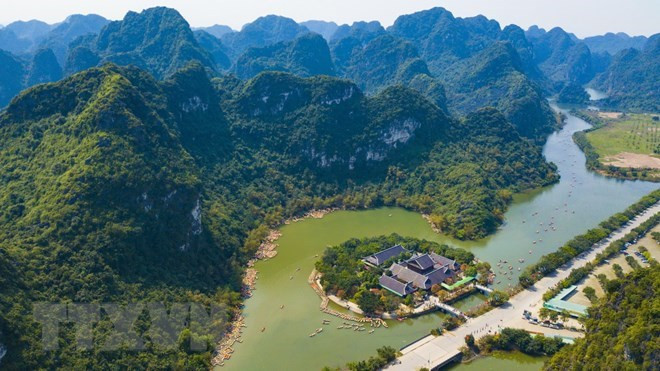Ninh Binh (VNA) – The northern province of NinhBinh will host various events this year to mark the 1,050th anniversary of the establishment of Dai Co Viet, the first feudal state ofVietnam.
The highlight will be a ceremony to celebrate the Dai CoViet establishment and launch Hoa Lu Festival, the largest and most spectacularfestival of the province slated for April 24-27 under the theme “The 1050-yearjourney of Dai Co Viet State in the flow of history.”
The province will also hold a wide range of cultural andsport activities and festivals in April, including an art exchange programmebetween Ninh Binh and Asan city (Republic of Korea), Oudomxay (Laos), Bac Lieu,Ca Mau and Tuyen Quang provinces among others, a national workshop on role ofDai Co Viet in the country’s history, art and photo exhibitions and Thai ViTemple and Trang An festivals.
In 2018, Ninh Binh will publish books on local intangiblecultural heritages and socio-economic development of the province from2015-2018, host the beauty pageant “Miss Hoa Lu” and for the first time, organisea local tourism week promoting the beauty of the Tam Coc and Trang Ancomplexes.
The events will provide people with a betterunderstanding of the role and historic values of Dai Co Viet and promotesignature cultural and natural beauties of Hoa Lu ancient capital, according toPham Quang Ngoc, head of the provincial Party’s Committee Board of Informationand Education.
In the late 10th century, Hoa Lu was capital and theeconomic, political and cultural centre of Dai Co Viet founded by Dinh BoLinh (968-979), and then the Early Le Dynasty (980-1009).
Dai Co Viet (Great Viet) wasthe first centralised feudal state in Vietnam which existed from 968 to 1010 AD.It was also the native land of three royal dynasties: the Dinh, the early Leand the Ly. Hoa Lu was the first capital of the country until King Ly Thai To moved the capital to Thang Long (nowHanoi) in 1010.
In the late 10th century, Vietnam was fragmentedand was later reunited by Dinh Bo Linh, who founded the Dinh Dynasty in 968 andascended to the throne under the name Dinh Tien Hoang.
The emperor chose Hoa Lu as his capital as it wasprotected by the Trang An mountains on three sides and by the Hoang Long Riverto the northwest. With strong walls linking the limestone mountains, Hoa Lu hadnatural defences but also allowed the emperor’s forces to mount attacks againstfoes and to communicate with their subjects.
Over 42 years, the Dinh and the early Le dynastieserected palaces, temples and shrines within the centre of the nation’s citywalls. Due to the ravages of time, there are only about 30 vestiges related tothe dynasties remaining, including the temples of King Dinh Tien Hoang and KingLe Dai Hanh and Nhat Tru Pagoda.
The 300-ha Hoa Lu ancientcapital is now a popular tourist destination in Ninh Binh, famous for beautifullandscapes with magnificent lime mountains and rivers.-VNA



























